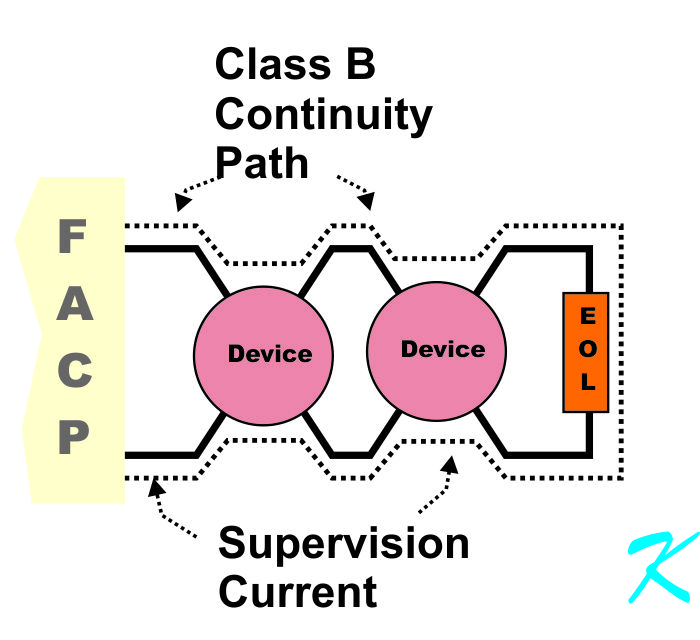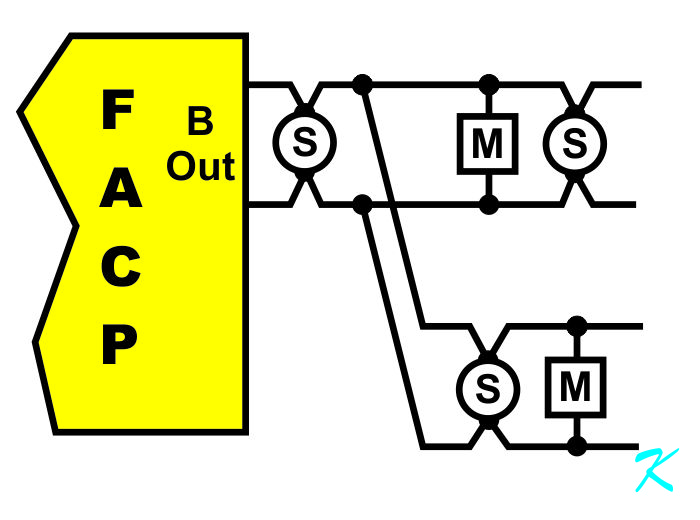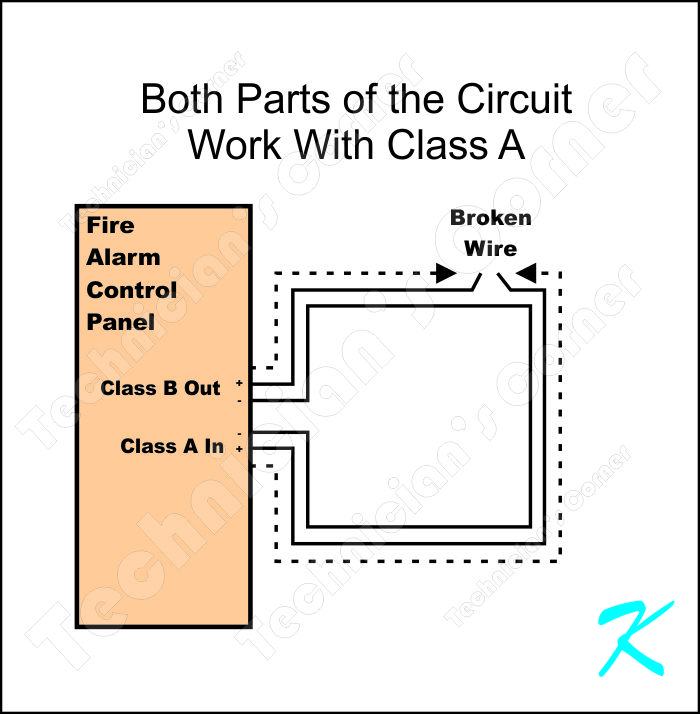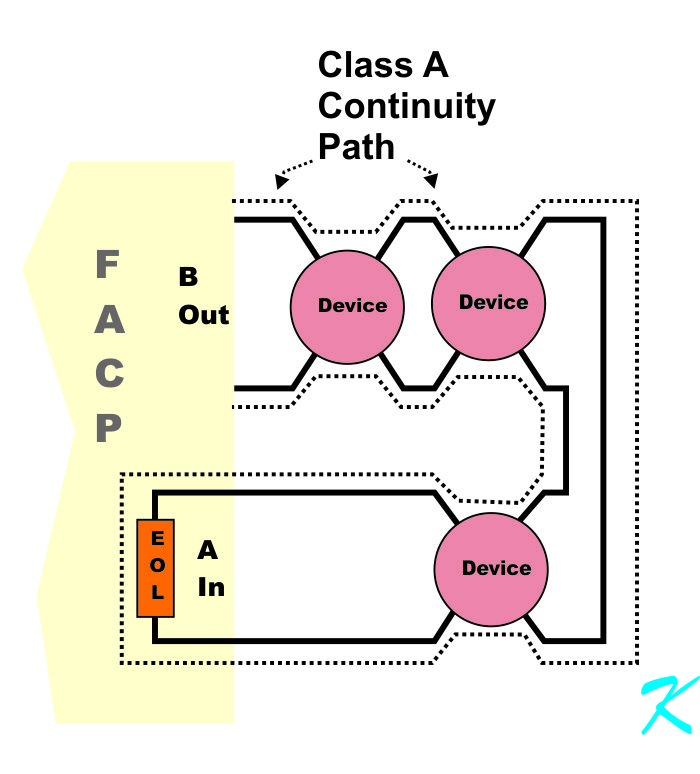I'm assuming that you are referring to an already installed and running fire alarm system. If it's a new fire alarm system, read the installation manual that is included inside the box. Reading the installation manual will show how the building-wide circuit should be wired.
Circuit Classification
When standing at the panel in order to recognize the difference between Class A and Class B, some understanding of the building-wide fire alarm system itself is required. The panel, if it can be used with Class A building-wide circuits, can often be programmed to use Class A or Class B circuits. Look at the building's circuit wiring itself to determine the classification of the circuit.
The National Fire Protection Association (NFPA) indicates how a circuit should be classified; the panel just has to be capable of working with the building-wide's circuit. In other words, the panel has to be compatible with the classification of the circuit.
The Class A and Class B circuit classifications can be applied to the conventional circuits, as well as to the addressable circuits. Because the circuits can be either conventional or addressable, the Class A and Class B circuit classifications can be applied to the function of the circuit: the conventional zone input circuits (Initiating Line Circuit or IDC), the conventional output circuits (Notification Appliance Circuit or NAC), the two wire addressable circuits (Signaling Line Circuits or SLC).
Class A and Class B circuits are the very most common classification, however, there are other commonly used classifications shown in the National Fire Protection Association's NFPA 72 Code book. A summary of what is shown in the NFPA 72 can be found at:
NFPA's 7 Classes of Fire Alarm Paths
Class B Circuits
With a Class B circuit or pathway, if something goes wrong with a Class B circuit, the panel will show a trouble.
Conventional Class B Circuits

Using two screw-terminals on the panel itself, conventional Class B circuits only supervise the wires (pathway), The panel checks continuity of the wires, and requires an end of line resistor to complete the building-wide circuit.
If the supervision current stops for any reason, the panel shows a trouble.
Both the IDC circuit and the NAC circuit are supervised this way. In regard to both the IDC and the NAC, if they only have two conductors connected to the panel, the circuit can be classified as Class B.
Addressable Class B Circuits

Using two screw terminals on the panel itself, addressable Class B circuits are device supervised. The devices are continually checked to see if they are connected. When the panel can digitally communicate with all the devices, the wire pathway of the circuit is assumed to be complete.
If the panel can't communicate with a device, the panel shows a trouble.
Class A Circuits
If there's a problem with the circuit wiring, so some of the devices would be disconnected, Class A circuits can use an alternate path to keep all the devices connected.

Whether it's a conventional circuit or an addressable circuit, a Class A circuit uses a primary route (pathway) to communicate with all the devices. If a wire breaks or comes loose from a connection, the primary path that the panel uses to communicate with the devices is blocked. Because the pathway is blocked, the panel automatically switches to using both the primary path, and an alternate path, to communicate with all the devices.
Conventional Class A Circuits

A conventional Class A circuit is still wire supervised. To be a Class A building-wide circuit, though, the pathway ends are inside the circuitry of the panel. If a wire breaks or comes loose, the panel automatically switches to using the Class A input on the panel to also communicate with the devices.
If the supervision current stops for any reason, the panel shows a trouble.
Addressable Class A Circuits

Addressable Class A circuits are still device supervised, just like addressable Class B circuits are device supervised. When the panel can digitally communicate with all the devices, the wire pathway of the circuit is assumed to be complete.
If the panel can't communicate with a device, the panel shows a trouble.
In addition to supervising the devices, the panel also supervises the continuity of the wires. Exactly how the panel supervises the wires is proprietary, and is different with each manufacturer. The bottom line, however, is that the wires have to be complete from the Class B output of the panel, through the building wide circuit wiring, and all the way to the Class A input on the panel.
If the signal is blocked from going through the entire circuit from the panel's Class B output screw terminals, to the Class A input screw terminals, the pathway is in trouble.
When the Class A pathway is blocked, the panel shows a trouble, often calling the trouble a "Class A Trouble".
When the pathway is blocked, the Class A input screw terminals are automatically switched to same output signals as is on the Class B output terminals, providing an alternate path for the signals.
Class A or Class B
When trying to see whether a building-wide circuit is Class A or Class B, there are variations to the rules. However, at least in most installations, if the circuit is a Class B circuit, there are only two circuit conductors connected to the panel. If the circuit is a Class A circuit, there are four circuit conductors connected to the panel.
Douglas Krantz






